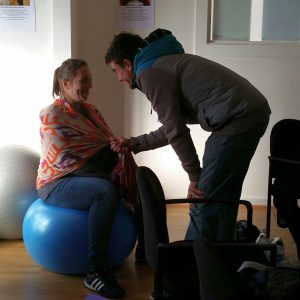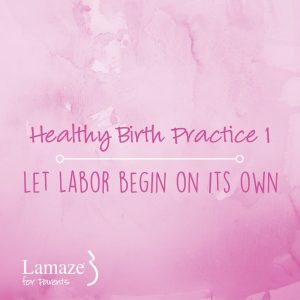Ask the Childbirth Educator… how to get labour started
Welcome to the first column in our new series, Ask the Childbirth Educator. Do you have a question regarding pregnancy, birth or early parenting? Send us an email with your question and we’ll feature it on our blog!
Today’s question comes from Tasha.
What are ways to start labour (for later on)? Also how early can you get Braxton Hicks? Also is there any way to stop back pain? I’m 33 weeks pregnant and this back pain is getting me down at the moment. Anything to help would be fantastic.
Tasha
Dear Tasha,
First of all, I know how interminable pregnancy can seem. Sometimes you feel like you are going to be pregnant FOREVER! Hang in there – you’re almost at the end!
Your questions are really common experiences for women in late pregnancy and there are definitely lots of things you can do to help relieve the aches and pains of your third trimester.
Regarding your question about Braxton Hicks contractions (sometimes called practice contractions). They can start in the second trimester, but most women don’t start to feel them properly until into the third trimester. They should not be painful, nor should they have any regularity to them. If you do find that they start to intensify in feeling and become regular, then you should contact your healthcare provider straight away, as this could be a sign of preterm labour.
Many women, especially late in pregnancy, experience back pain. This is not surprising given how much additional weight you are carrying in your front at this point and that your centre of gravity has shifted. Lower back pain can also be a sign that your baby is in a posterior position, which means that your baby’s spine is lined up with your spine and during labour especially, this can cause a lot of lower back pain and a longer first stage of labour. As you are only 33 weeks, I wouldn’t worry too much about that because your baby still has plenty of time to move into an optimal position for labour. Check out Spinning Babies, a fantastic website and resource to help you optimise your baby’s position for birth.
There are lots of things you can do to relieve back pain in pregnancy. Maintaining good posture will go a long way to taking the pressure off your spine. Be sure to sit in a well-supported chair and try not to slouch on the sofa too much (as tempting as I know it can be!). If you are still working, especially if you are in an office job and sitting at a computer all day, be sure to do neck and shoulder rolls regularly and try to get up and walk around for a few minutes at least once an hour to improve your circulation.
 A good investment is to buy a fit ball (also known as a birth ball). You can get one from any good sports store (even Aldi and KMart sell them, so keep an eye out for when they are on special!) and it will be a great labour comfort tool for you to have at home when labour begins as well. Fit balls are great to sit on and rotate around. Sitting on the ball really helps to alleviate back pain and also takes the pressure off your pelvic floor.
A good investment is to buy a fit ball (also known as a birth ball). You can get one from any good sports store (even Aldi and KMart sell them, so keep an eye out for when they are on special!) and it will be a great labour comfort tool for you to have at home when labour begins as well. Fit balls are great to sit on and rotate around. Sitting on the ball really helps to alleviate back pain and also takes the pressure off your pelvic floor.
You can also lean over the ball and roll forward to stretch out your lower back. Be sure to protect and cushion your knees though by placing them on a pillow or a mat. Want to learn some more techniques for using a birth ball? Click here then!
Other exercises you can do are pelvic tilts. These help to strengthen your abdominal muscles, improve posture and relieve back pain. There are a few ways to do them, so feel free to try them out and see what is most comfortable and beneficial for you.
On a yoga mat, get on your hands and knees. Keep your back in a neutral position (neither sagging nor arched) and your knees hip-width apart. As you tighten your abdominal muscles, your pelvis curls under and your lower back arches. Your upper back may arch as well. This is really a variation on a yoga position, called “Cat Cow” and I found a good YouTube link on how to do it here.
You can also lean against a wall with knees slightly bent and feet apart and about 30cms away from the wall. Let your bottom and shoulders touch the wall. As you contract your abdominal muscles, your back presses against the wall.
At night when you are sleeping, make sure your body is well supported. Many women like to have a pillow wedged behind their back and another one under their tummy or between their legs.
 Finally, when it comes to getting labour started, the most important thing to remember is, let labour begin on its own (which happens to be the first of Lamaze International’s Six Healthy Birth Practices). All the best evidence-based research has shown that going into spontaneous (natural) labour when you and your baby are ready for that process to begin, is the best possible way to ensure that your labour remains low-risk and uncomplicated.
Finally, when it comes to getting labour started, the most important thing to remember is, let labour begin on its own (which happens to be the first of Lamaze International’s Six Healthy Birth Practices). All the best evidence-based research has shown that going into spontaneous (natural) labour when you and your baby are ready for that process to begin, is the best possible way to ensure that your labour remains low-risk and uncomplicated.
Watch this excellent video which explains all about Healthy Birth Practice #1: Let Labour Begin on its Own.
I hope these tips are useful. Wishing you all the very best!
Tanya x
Tanya Strusberg is the founder of birthwell birthright. She is a Melbourne-based Lamaze Certified Childbirth Educator and a Fellow of the Association of Certified Childbirth Educators (FACCE). She is a passionate advocate for women’s maternity care and her articles have appeared in The Journal of Perinatal Education, Australian Midwifery News, Science & Sensibility, International Doula – official magazine of DONA International, Interaction – the journal of the Childbirth and Parenting Educators Association of Australia (CAPEA), Empowering Birth Magazine and Rockstar Birth Magazine. Through her internationally-accredited Lamaze Educator Training program, she is very excited to be training a new generation of Australian Lamaze educators. Last, but absolutely not least, she is also the mum of two beautiful children, her son Liev and daughter Amalia.
Disclaimer: The information contained in this column is of a general nature only and does not constitute formal medical advice. Any specific medical problem should be referred directly to your healthcare provider.
